Measure the blood pressure
Correct placement of the cuff is important. Hold the patient?s arm out straight, palm upwards. (You can help by tucking his wrist under your elbow, as shown.) Start applying the cuff in the middle of the upper arm, with the tubes uppermost, and placed in line with the brachial artery.
| AFRIKAANS | TRANSCRIPT | XHOSA |
|---|---|---|
| I need to take your blood pressure. / Ek moet u bloeddruk meet. / Kufuneka ndithathe iBP yakho. | ||
| Please give me your arm. / Gee my u arm, asseblief. / Ndicela undinike ingalo yakho.td> | ||
| I?ll put this cuff around your arm./ Ek sal hierdie band om u arm sit. / Ndiza kufaka eli bhanti apha engalweni. | ||
| It will be uncomfortable. / Dit sal ongemaklik wees. / Akuzokuva kamnandi, | ||
| I?ll try to be quick. / Dit sal nie lank neem nie. / Ndiza kuzama ukukhawulezisa. | ||
| Thank you, that?s fine. / Reg so. Dankie. / ... Enkosi. Kulungile. |
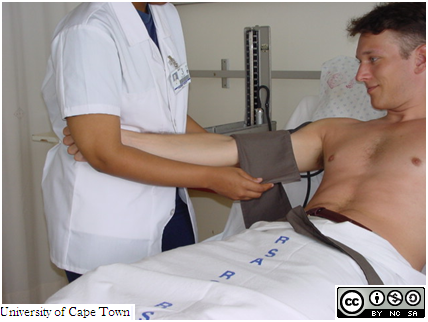
Wrap the cuff around the upper arm neatly and fairly tightly. Finish by tucking in the free end to hold it firmly, or apply the Velcro fastener if it has one.
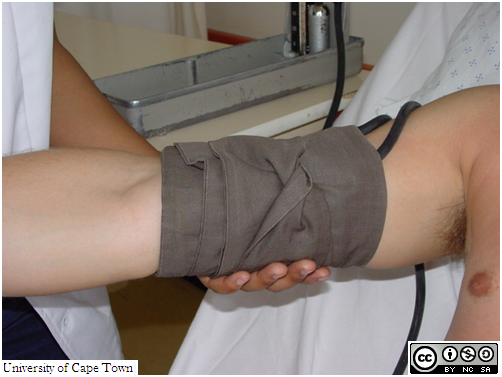
Watch how the cuff is applied:
And, finally, tucked in and adjusted so that the tubes lie neatly over the upper arm in line with the brachial artery.
Initially you will determine the systolic blood pressure by palpation. Feel the brachial pulse as you did before, but you may find it easier to use your left hand so that your right hand is free to manipulate the valve of the sphygmomanometer.
| AFRIKAANS | TRANSCRIPT | XHOSA |
|---|---|---|
| I?m just trying to find this pulse. / Ek probeer net u polsslag vind. / Ndizama ukufumana lo mthambo. |
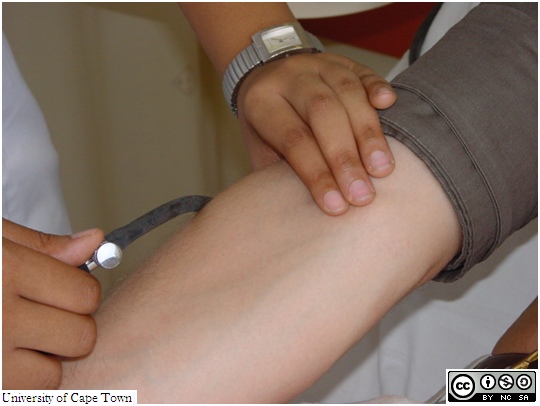
Now close the valve of the sphygmomanometer and pump up the cuff until the brachial pulse disappears. Pump once or twice more.
| AFRIKAANS | TRANSCRIPT | XHOSA |
|---|---|---|
| I?m going to pump up the cuff now, it will feel tight. / Ek gaan nou die band oppomp. Dit sal styf wees. / Ndiza kumpompa eli bhanti ngoku, lizakukuqinisa. |
Release the valve partially, so that the pressure is slowly released. Watch the mercury column. Note the height at which the pulse reappears. This is the palpated systolic blood pressure. Once you have noted this, you can release the rest of the air quickly.
You will follow this by determining both the systolic and the diastolic blood pressure by auscultation. Place your stethoscope in your ears. Then identify the brachial pulse with your fingers.
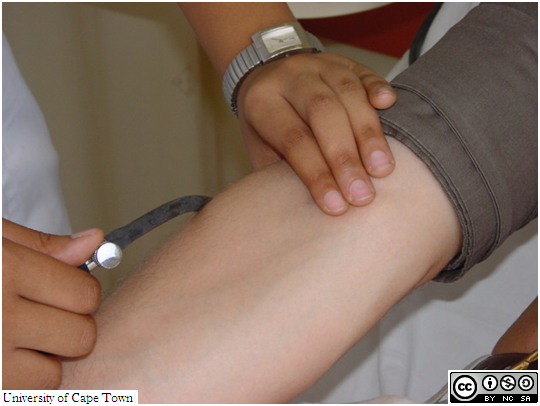
Now place the diaphragm of your stethoscope firmly over the brachial pulse. (You will not hear anything yet.)
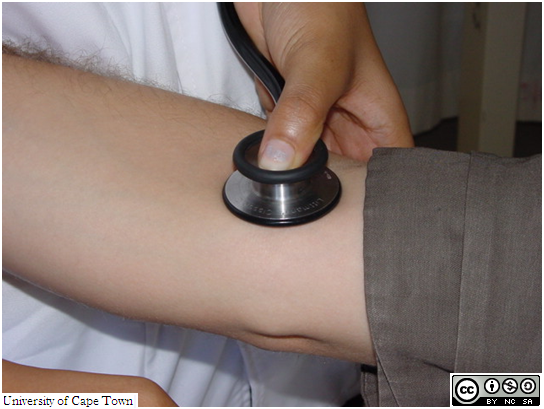
Now close the valve of the sphygmomanometer and pump up the cuff to a pressure higher than the systolic determined by palpation.
Release the valve partially, so that the pressure is slowly released. Watch the mercury column while listening carefully. Note the height at which sounds synchronous with the heart beat first become audible. This is the systolic blood pressure. Continue decreasing the pressure and note the pressure at which the sounds disappear. This is the diastolic pressure. Thereafter you can release the rest of the air quickly. The reading is then reported as Systolic/Diastolic mmHg.
